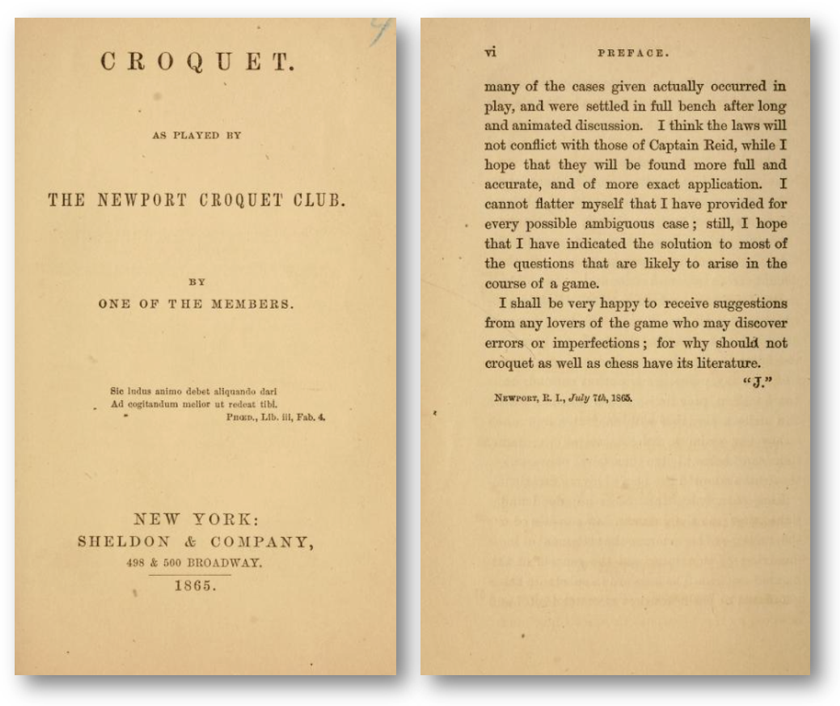Who Wrote "Croquet, as Played by the Newport Croquet Club"?
“J” Unmasked
By Allen Scheuch
For more than a hundred-and-fifty years, the author of one of the earliest croquet booklets in the U.S. has remained a mystery. It wasn’t, it seems, a terribly pressing question, though over the decades an occasional sleuth tried to crack the case. The booklet’s preface was simply signed “J.,” while the title page (above) only indicated it was “By One of the Members” of the Newport Club. As it turns out, when the volume first appeared, the name of the shadowy pen behind it wasn’t such a closely held secret. Friends and family of the author knew the identity of “J,” as did members of the then newly formed Newport Croquet Club. However, almost no hints were left in print, so as the years passed, fewer and fewer people knew the author’s identity.
In the early 1980’s I was fortunate to latch onto a good first edition of the work by quickly responding to a book dealer’s small catalogue of offerings. Those were yet the days of collectors snail-mailing notes of inquiry, attending shows and once in a while hitting gold. The internet tsunami hadn’t arrived, the latest American croquet revival still wasn’t in full swing, and quite a few interesting items that turned up at auction failed to find buyers even at rock bottom prices. Sometimes it took a while to appreciate the rarity of what was being offered - often neither seller nor buyer recognized how special it was. It was an ideal time to collect croquet material.
In the case of Croquet, as Played by the Newport Croquet Club, copies seldom surface. At first it appeared that there were just two editions; David Drazin listed only the pair in his seminal croquet bibliography (Oak Knoll Press, 2000). Now we know there were at least three: 1865, 1867 and 1868. It didn’t occur to me to make an effort to solve the mystery until I read Drazin’s 2004 piece in Croquet World Online Magazine, ”Unsolved Mysteries of Croquet History,” where he wrote:
“The majority of rulebooks from the 1850’s and 1860’s were published anonymously or signed by initials or assumed names. Maybe their authors chose to remain anonymous out of modesty, not to imply originality. The first three would be my prime targets: Rules of the Game of Croquet (1862) by ‘G.V.H.’, The Laws of Croquet as Played by the Medes and Persians (1865) by ‘Rab-Mag’, and Croquet: As Played by the Newport Croquet Club (1865) by ‘J’, “One of the Members”.
Drazin concluded with a plea for assistance: “If you can shed light on any of these mysteries, don’t keep it to yourself.”
Possessing the Newport book was nice, but it didn’t solve the mystery of who wrote it. A circa 2005 phone call to the Archives of the famed Newport Casino (opened in 1880) quickly revealed that no list of members of the 1860’s Newport Croquet Club was known to exist. Indeed, no one seemed to know when the Club was formed, when it ceased to be and whether it had really been a formal club at all.
Had I not digested Drazin’s article prior to perusing a June, 1866 Atlantic Monthly review of four different croquet booklets, I would likely never have had my “Eureka!” moment while reading the following sentence:
“The so-called manual of the ‘Newport Croquet Club’ is understood to proceed from a young gentleman whose mathematical attainments have won him honor both at Cambridge and at New Haven, and who now beguiles his banishment as Assistant Professor in the Naval Academy by writing on croquet in the spirit of Peirce.”
Here was a clue, a lead that could be followed, and an implicit challenge to follow it by a reviewer of yore.
It was easy enough to read “New Haven” as “Yale” and then assume that “Cambridge” meant “Harvard,” but the latter assumption turned out to be wrong. A red herring had been cleverly inserted, both to assist the croquet book’s author in maintaining anonymity (more on this later) and to tempt the readership to uncover his identity. I took the bait, and made the mistake of thinking Harvard was involved. When I subsequently reached out to the Naval Academy’s Nimitz Library in 2011 to ask for a list of professors who taught mathematics there in the 1860’s, I requested names of professors that had both an undergraduate degree from Yale and a graduate degree from Harvard.
Barbara Kemp, then Head of Reference and Instruction at the Nimitz, swiftly responded with two suggestions which didn’t exactly fit the bill but which she thought might still prove valuable (thank you, Barbara!): Samuel Pierpont Langley, whose honorary degrees included ones from Princeton and Harvard; and William Woolsey Johnson, who had an 1862 BA from Yale but no degree from Harvard. Still, Johnson seemed like an excellent candidate and I soon discovered in Wikipedia that “after two years serving in the Nautical Almanac Office in Cambridge, Massachusetts, he began his academic career as assistant professor in the Naval Academy in Newport, Rhode Island, but soon transferred to Annapolis, Maryland.” That the Naval Academy had ever been located in Newport was a surprise to me. In fact, it had moved to Newport from Annapolis for the duration of the American Civil War (1861-1865).
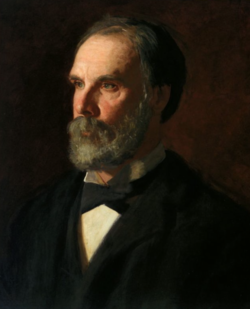 Professor William Woolsey Johnson, 1841- 1927. Portrait by Thomas Eakins, 1896. Image is in the public domain. PD-1923. (Click to Zoom)
Professor William Woolsey Johnson, 1841- 1927. Portrait by Thomas Eakins, 1896. Image is in the public domain. PD-1923. (Click to Zoom)
I believed I had found my man.
The Atlantic’s “Cambridge” was simply where the Nautical Almanac Office was located, it was not Harvard. For the 1864-1865 academic year, then, Johnson was in Newport teaching at the Naval Academy in its last year there, where he would have swung his mallet with the Newport Club over at least some of the following summer and where on July 7th he finished the preface to his croquet book. By 1866 when the Atlantic article was written, he had moved to Annapolis to teach at the newly returned, post-war Naval Academy. Croquet, as Played by the Newport Croquet Club is one of the four or five earliest books on the game published in the U.S. The cryptic “J” now surely seemed to stand for “Johnson.”
The next step was to find some clear written reference by Johnson to his book, or some mention of it in a letter to him from a family member, his publisher, a friend or some other acquaintance.
Then, just as I felt very close to irrefutably establishing WWJ as the author of Croquet, as Played by the Newport Croquet Club, I lost interest in the project. For six years.
Last year in the crisp New England fall I rolled north on Route 95 from my home in Cobble Hill, Brooklyn, to examine the William Woolsey Johnson archive of the Sterling Memorial Library in New Haven. Its online catalog detailed two boxes of mostly family correspondence from 1853 to 1903. The handwritten letters included weekly epistles from Johnson to his young fiancée, Susannah Leverett Batcheller, over the summers of 1867 and 1868. Will (as he signed his letters to Susie) was working hard to complete and find a publisher for his Elementary Treatise on Analytical Geometry in between his yearly Academy teaching duties. During those summers he lived with his parents at his childhood home in Owego, NY, while Susie stayed with her parents in Baltimore where she was raised. They would not live together under the same roof until they were married in August, 1869. It was my hope that Will’s letters to one with whom he was likely to have shared his identity as a croquet author would contain some mention of croquet and perhaps a specific reference to his book on the game as played by the Newport Club.
I was not disappointed.
For the most part the letters were filled with distant lovers’ ruminations and daily routines, descriptions of family and special activities. It was a one-sided affair since Susie’s letters to Will are not in the collection. In spots Johnson's handwriting was difficult to decipher and the going was slow, but five or six mentions of croquet in the first group of letters gave me repeated boosts and clearly reflected a man with more than a passing interest in the game.
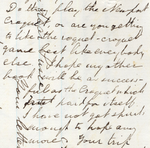 William Woolsey Johnson Papers (MS 954). Manuscripts and Archives, Yale University Library. (Click to Zoom)Finally, at the end of my first visit to the Library came a very rewarding find. Johnson’s habit was to use all four sides of a single sheet of paper folded in half, and he frequently ran out of space on the last page and ended his letter atop the first page, filling the area where his opening had left empty space. In several letters he wrote vertically, shifting his lines ninety degrees to eke out another sentence or two before signing off. Such was the case on July 28th, 1868, when he penned the following:
William Woolsey Johnson Papers (MS 954). Manuscripts and Archives, Yale University Library. (Click to Zoom)Finally, at the end of my first visit to the Library came a very rewarding find. Johnson’s habit was to use all four sides of a single sheet of paper folded in half, and he frequently ran out of space on the last page and ended his letter atop the first page, filling the area where his opening had left empty space. In several letters he wrote vertically, shifting his lines ninety degrees to eke out another sentence or two before signing off. Such was the case on July 28th, 1868, when he penned the following:
“Do they play Newport croquet, or are you getting to like the roquet-croquet game best like everybody else. I hope my other book will be as successful as the Croquet (book) which fast paid for itself. I have not got spirits enough to hope any more.” (corner detail of page to right)
I ended the day wondering if I needed to make another trip to examine the rest of WWJ’s letters from this same period. I was satisfied I had uncovered a connection to pinpoint Johnson as the author of the heretofore anonymous Newport Croquet volume. But when I returned the following week, I was doubly delighted to have made the trip.
The session began with the uncovering of an interesting croquet paragraph in Will’s letter to Susie dated September 4, 1868, just before his return to Annapolis:
“I wish you could play croquet on our ground and see how much more of a game it can be made by our rules. The other game is well enough to take you outdoors and give you a gentle exercise and a sort of round game but one would hardly come to play it with a single adversary, at least if they liked the game so much as I do and knew the points in it. I see persons play the other game, and wonder they can take any interest for half the nice points are out of the question with it. The interest in the game is dying out because of that very thing and I don’t like it because it spoils my book. Such heresies can’t be very easily introduced into my analytical geometry.”
This was good stuff, but the letter that cemented Johnson’s authorship of the Newport Croquet Club booklet was not one Will wrote. It was a cheerful letter to Will from one of the most eminent Americans of his day: Thomas Wentworth Higginson, he of Emily Dickinson fame, minister, abolitionist, Colonel in the first black regiment in the Civil War, contributor to the Atlantic Monthly and … member of the Newport Croquet Club! Having read Will’s letters to his fiancée, I find it curious that Higginson and Johnson had much in common, except croquet and having chanced to overlap in 1864-1865 in Newport where Col. Higginson might have been recuperating from his war wounds received in August of 1864. But that incongruity is another tale. There were in Newport a number of other croquet enthusiasts and vacationers connected to the Atlantic Monthly who perhaps declared themselves as constituting the Newport Croquet Club for a summer or two. Higginson’s letter to Johnson is worth a look, and it seems that he himself might have written the Atlantic review in which I had found the clue. Here is his letter of May 22, 1866 in which he uses the early American croquet term "bridges" (meaning wickets or hoops):
Newport, R.I.
May 22, 1866My dear friend
The only excuse I can offer for delaying a thank you for the croquet manual is that I always thought I would do it in print + by letter at the same time; + having been desperately ---- this winter, the printed part hung ----. At last it has gone off in the June “Atlantic”, + I hope you will do as I find most persons do when their books are criticized, - swallow the sugar + waive the pill. I did like the book very much, + hope it will be vigorously advertised and sold though I see no signs of the former.Of course our own croquet season opens with some energy, + already has there been a game by moonlight, with handkerchiefs hung over the bridges. Miss Stone leads us at present + plays capitally : Miss May, as perhaps you know, is head proof-reader at the Cambridge University Press, where she is highly esteemed, but loses the laurels of croquet.
We have some pleasant lady allies, however, Mrs. Kent, who is in residence, + Miss Kate Field, the friend of Mrs. Browning’s + Landon (see Atlantic) who is patiently learning. We miss you all however. Pray give my regards to your mother + to Mr. + Mrs. Hyde + Mr. Asnes. My wife is about as well as when you were here, + we are to board at the “Point” this summer, + when here in the autumn.
Ever cordially yours
Thomas Wentworth Higginson
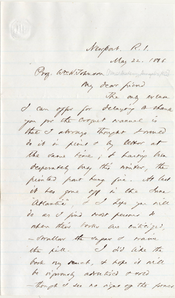 May 22,1886 Higginson letter. William Woolsey Johnson Papers (MS 954). Manuscripts and Archives, Yale University Library. (Click to Zoom)
May 22,1886 Higginson letter. William Woolsey Johnson Papers (MS 954). Manuscripts and Archives, Yale University Library. (Click to Zoom)
The information in the letter above should end once and for all the mystery of who wrote Croquet as Played by the Newport Club. I hope enough has been adequately stitched together here to shine a bright, convincing spotlight upon the mathematician from Owego, NY as the booklet’s long-unidentified author. A discussion of the book's merits and shortcomings is in order; and there are likely more Newport croquet discoveries to be made, which I will leave to another enterprising, croquet-captivated soul. Certainly, if the archives of the book’s first publisher, Sheldon & Co., still exist somewhere, they might corroborate my conclusion; likewise, if Johnson’s future wife Susie’s letters to him over the summers of 1867 and 1868 could be found they might confirm him as the author. And maybe there is a note from Will to his older friend Higginson in some collection.
Johnson went on to write several well-received mathematical textbooks and was one of the founders of the American Mathematical Society in 1888. His marathon teaching career took him first to the U.S. Naval Academy from 1864 to 1870 as an assistant professor, followed by a full professorship at Kenyon College for two years and then to St. John’s College from 1872 to 1881. His final, impressive stint of forty years from 1881 to 1921 was spent back at the Naval Academy, from which he retired at the age of eighty.
Today one of the most (if not the most) famous U.S. collegiate croquet rivalries is carried on between the Naval Academy and its Annapolis neighbor, St. John’s College. The yearly contest began over twenty years ago and is a highlight of the calendar. There is evidence that in the early decades of croquet in America, the game was played at the Academy. In a circa 1870 series of stereo views of the Naval Academy by W.M. Chase (father of the famous American painter), view no. 855 is titled “Croquet Ground and Officers’ Quarters”. Jennifer Bryan, Head of Special Collections and Archives at the Academy’s Nimitz Library, supplied the photograph below from James Russell Soley’s 1876 Historical Sketch of the Academy. Croquet wickets are visible on the left in front of the “New Cadets’ Quarters”. Could Professor Johnson have been a croquet ambassador to the colleges where he taught?
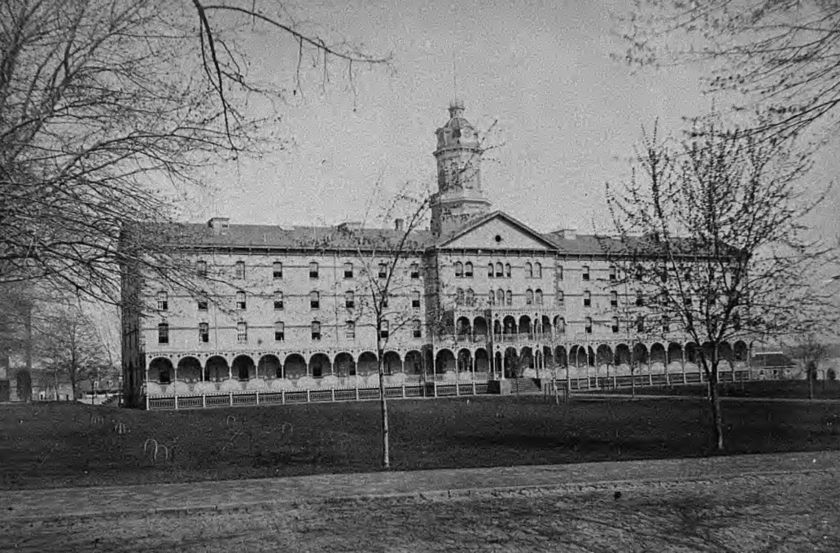 1876 USNA croquet court photo. Special Collections & Archives Department, Nimitz Library, United States Naval Academy. (Click to Zoom)
1876 USNA croquet court photo. Special Collections & Archives Department, Nimitz Library, United States Naval Academy. (Click to Zoom)
The question lingers of why Johnson preferred to remain anonymous and the answer is yet unknown. One can imagine that a fledgling professor might fear not being taken seriously in the halls of academe if word got out that his first published work was on the game of croquet. If the plan was to avoid that, then it worked; and it kept on working, for a very long time.
Allen Scheuch lives in Brooklyn, N.Y. and since 1983 has been collecting croquet across the board.
